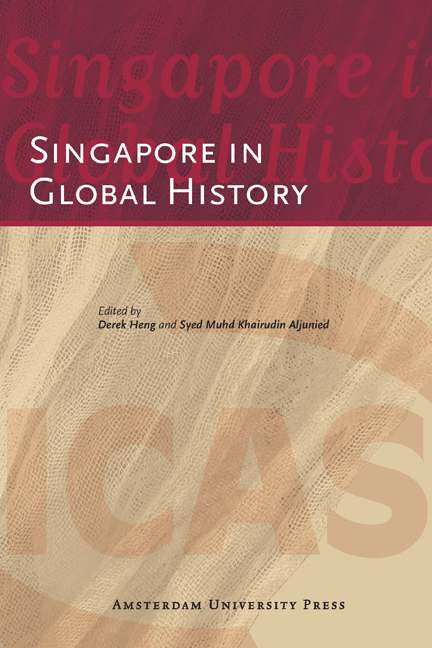Book contents
- Frontmatter
- Contents
- List of Tables and Illustrations
- Foreword
- 1 Globalising the History of Singapore
- 2 Situating Temasik within the Larger Regional Context: Maritime Asia and Malay State Formation in the Pre-Modern Era
- 3 The Singapore River/Port in a Global Context
- 4 ‘Walls of Illusion’: Information Generation in Colonial Singapore and the Reporting of the Mahdi-Rebellion in Sudan, 1887-1890
- 5 The Littoral and the Literary: Making Moral Communities in the Straits Settlements and the Gold Coast in the late Nineteenth and Early Twentieth Century
- 6 Social Discourse and Economic Functions: The Singapore Chinese in Japan’s Southward Expansion between 1914 and 1941
- 7 The Dynamics of Trans-Regional Business and National Politics: The Impact of Events in China on Fujian-Singapore Tea Trading Networks, 1920-1960
- 8 Rambutans in the Picture: Han Wai Toon and the Articulation of Space by the Overseas Chinese in Singapore
- 9 The Global Effects of an Ethnic Riot: Singapore, 1950-1954
- 10 The British Military Withdrawal from Singapore and the Anatomy of a Catalyst
- 11 Bringing the International and Transnational back in: Singapore, Decolonisation, and the Cold War
- 12 The Global and the Regional in Lee Kuan Yew’s Strategic Thought: The Early Cold War Years
- 13 A Brief History of the Hub: Navigating between ‘Global’ and ‘Asian’ in Singapore’s Knowledge Economy Discourse
- About the Contributors
- Bibliography
- Miscellaneous Endmatter
10 - The British Military Withdrawal from Singapore and the Anatomy of a Catalyst
Published online by Cambridge University Press: 02 February 2021
- Frontmatter
- Contents
- List of Tables and Illustrations
- Foreword
- 1 Globalising the History of Singapore
- 2 Situating Temasik within the Larger Regional Context: Maritime Asia and Malay State Formation in the Pre-Modern Era
- 3 The Singapore River/Port in a Global Context
- 4 ‘Walls of Illusion’: Information Generation in Colonial Singapore and the Reporting of the Mahdi-Rebellion in Sudan, 1887-1890
- 5 The Littoral and the Literary: Making Moral Communities in the Straits Settlements and the Gold Coast in the late Nineteenth and Early Twentieth Century
- 6 Social Discourse and Economic Functions: The Singapore Chinese in Japan’s Southward Expansion between 1914 and 1941
- 7 The Dynamics of Trans-Regional Business and National Politics: The Impact of Events in China on Fujian-Singapore Tea Trading Networks, 1920-1960
- 8 Rambutans in the Picture: Han Wai Toon and the Articulation of Space by the Overseas Chinese in Singapore
- 9 The Global Effects of an Ethnic Riot: Singapore, 1950-1954
- 10 The British Military Withdrawal from Singapore and the Anatomy of a Catalyst
- 11 Bringing the International and Transnational back in: Singapore, Decolonisation, and the Cold War
- 12 The Global and the Regional in Lee Kuan Yew’s Strategic Thought: The Early Cold War Years
- 13 A Brief History of the Hub: Navigating between ‘Global’ and ‘Asian’ in Singapore’s Knowledge Economy Discourse
- About the Contributors
- Bibliography
- Miscellaneous Endmatter
Summary
“It was not even a sell-out: it was a handout, with virtually nothing demanded or even bargained for in return”, an angry Arthur de la Mare, the former British High Commissioner in Singapore, wrote to the Secretary of State for Foreign and Commonwealth Affairs in November 1971. De la Mare was reflecting on the handover of the British military bases to the Singapore's People's Action Party (PAP) government between 1968 and the end of December, when the remaining British forces would depart from Britain's chief base in Southeast Asia. De la Mare castigated his colleagues for conceding the bases to Singapore without retaining a say in their deployment for economic purposes. With more than a tinge of regret, he lamented, “Had we so wished we had the opportunity not only to retain all that we needed but also to transform Singapore from a doubtful military bastion (it was never a very good one) into the forward base of British business and commerce in East Asia”. It was a scathing comment on the end of Singapore's role in the British Empire.
Between crisis and catalyst
Yet, De la Mare's remarks also reveal much about Singapore's emerging new place in world history as a development-driven, industrial state at the end of the 1960s. They lend support to a new approach that extends beyond the imperial and national history frameworks within which narratives of the British withdrawal have usually been located. Imperial historians such as John Darwin, looking through a Britain lens, typically focus on its struggles to maintain a world presence in the 1960s and the convoluted process by which this ‘East of Suez’ policy was finally abandoned (Darwin 1988, 1991). When the call to pull out was finally made in January 1968, some historians have attributed it to the force of economics, particularly the sterling crises of 1966-67 and the devaluation of the pound in November 1967 (Darby 1973; Butler 2002; Hyam 2006). Other historians have pointed rather to the political actors: specifically, the cabinet reshuffle that undermined the old guard which had supported the ‘East of Suez’ policy (Darwin 1988; Pickering 1998).
- Type
- Chapter
- Information
- Singapore in Global History , pp. 195 - 214Publisher: Amsterdam University PressPrint publication year: 2012

